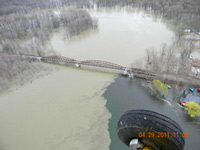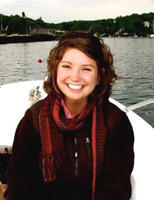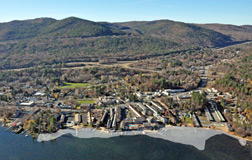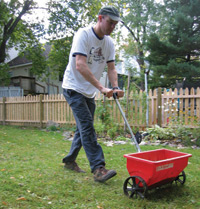|
|
|
|
|
|
|
RECORD LAKE
LEVELS BRING HEAVY SEDIMENT LOADING
|
|
Heavy rains and snowmelt brought Lake Champlain water
levels to record highs this spring. The lake stage shattered the
previous record of 102.1 feet above sea level on its way to a high of
103.27 feet in Burlington--more than three feet above flood stage--on
May 6. In immediate human terms, the flooding of homes, seasonal camps,
and waterfront businesses was devastating and caused major distress in
shorefront communities. While there will be time in the future for a
careful assessment of the flooding damage along the many tributaries
and on the Lake itself, it is clear that the impact on water quality
also will be very significant. The resulting sediment load to the Lake
is probably unprecedented.
|

|
|
A
sediment plume enters Lake Champlain from the Winooski River near
Burlington and Colchester, Vermont.
|
Photographs taken by LCBP Program Manager Bill Howland
document how record flooding and strong winds resulted in suspended
sediment plumes that are indicative of the nutrient load simultaneously
delivered into the Lake. The flood waters delivered nutrients to the
Lake both in dissolved form and attached to the surfaces of soil
particles. The Vermont Department of Environmental Conservation
estimated that the Winooski River discharged 33 metric tons of
phosphorus on April 27. This is nearly double the combined annual
phosphorus discharged from all wastewater treatment plants in the Basin
in Vermont in 2010 (18 metric tons).
River
discharge of sediments from upstream in the Lake's watersheds was
enormous, but a key part of the problem was that the zone of wave
action on the Lake itself was much higher than at any time in more than
a century, and powerful erosion processes were working on shoreline
sediments that have, in the past, been protected by their elevation.
|
|
|
|
|
LCBP PARTICIPATES IN TMDL
REVISION PROCESS
|
On January 24, 2011, the Environmental Protection Agency
(EPA) withdrew its approval of the Vermont portion of the Lake Champlain
Phosphorus Total Maximum Daily Load (TMDL), which had been in effect
since it was approved by the EPA in 2002.The EPA disapproved the TMDL
based on two primary areas of concern: the TMDL did not provide
sufficient assurance that phosphorus reductions from polluted runoff will
be achieved, and it did not provide an adequate margin of safety to
account for uncertainty in the analysis (particularly for four segments
of the lake: Missisquoi Bay, St. Albans Bay, Northeast Arm, and South
Lake).
Pursuant to Section 303 of the Clean Water Act, upon
disapproval of a TMDL, EPA must establish a new TMDL as determined to be
necessary to implement applicable water quality standards. The EPA New
England office initiated this revision in February 2011 and is working closely
with representatives from the Vermont Agency of Natural Resources, LCBP,
and other partners.The EPA, with the involvement of VT ANR, has convened
several subsequent meetings with technical experts from around the region
to review the modeling approach used in the 2002 TMDL and to seek input
on new approaches that should be considered for the revised TMDL. EPA has
contracted with TetraTech to complete the lake
modeling component of the TMDL revision, and has established a schedule
for overall TMDL completion by the end of 2012.
LCBP staff have been
participating in this revision process since the initial disapproval. We
are committed to supporting the EPA, VT ANR, and other partners wherever
necessary, to facilitate the development of a revised TMDL. LCBP also
expects to assist EPA and VT ANR with outreach to stakeholders during the
TMDL development process.
Full details of the EPA
disapproval decision and TMDL revision process can be found here: http://www.epa.gov/region1/eco/tmdl/lakechamplain.html.
|
|
BASIN
PROGRAM WELCOMES SUMMER INTERN
|
|
|

|
|
Emily Bird joined the
LCBP as summer intern in May.
|
Emily Bird joined the Lake Champlain Basin Program's
community as our summer intern in May. Emily will share outreach
responsibilities for student and adult watershed programs, and serve as
summer staff, greeting visitors at the Lake Champlain Basin Program
Resource Room in ECHO at the Leahy Center in Burlington, Vermont. She
also will assist with technical projects in the Grand Isle office. Emily
is a senior at the University of Vermont completing a B.S. in
Environmental Studies with a minor in Community and International
Development. Past experience includes a corporate sustainability
internship with Sappi Fine Paper, followed by a marine conservation
internship with Blue Ocean Society. Recent experience includes a position
as the UVM Eco-Reps Campus Coordinator along with a water quality
internship with New England Interstate Water Pollution Control Commission
(NEIWPCC) in Lowell, MA. Welcome Emily!
|
|
FARMERS
RECOGNIZED FOR COMMITMENT TO WATER QUALITY PROTECTION
|
|
With the announcement of the 2010 Farm Awards recipients in
February, LCBP continued its recognition of farmers who are working to
protect rivers and streams. In November 2010 LCBP staff and members of
the award committee visited several farms in New York, Vermont, and
Quebec that are implementing best management practices in an effort to
reduce their impact on water quality in the Basin. LCBP recognizes
annually one farm in each jurisdiction for their leadership in
environmental stewardship.
|

|
|
Three
generations of land stewards receive LCBP's Farm Award for Vermont at
Woodnotch Farms.
|
Stewardship of the land has been in the family for three
generations at Woodnotch Farms, and with a fourth generation begun
recently, is likely to continue. With their four sons, Loren and Gail
Wood keep 250 Holsteins on their Shoreham, Vermont, farm. The family has
conserved 1,220 acres of the farm and has worked with conservation
partners to exclude their heifers from Jones Brook. One-tenth of their
farm is in riparian buffer, with more than 36,000 trees planted in the
last few years. Other recent improvements include a silage leachate
treatment system and a piping system for transferring manure through
stream crossings on Route 22A.
Joe and Jana Garrant have been operating Maple Summit Farms
near Corbeau Creek, a tributary of the Great Chazy River in New York,
since 1987. In 2009, with assistance from the New York State Department
of Agriculture, they built a covered manure storage system to manage
waste from their 60 dairy cows. In addition to their 280-acre home farm,
they rent 45 acres that receives no manure and is managed for upland
wildlife. The Garrants have also reduced their solid waste stream by 80%
by recycling all agricultural plastic using the Clinton County Soil &
Water Conservation District baler.
Gilles and Sylvie Godin have operated their farm in Saint
Sabine, Quebec since 1987, and after a three-year transition period
during which no mineral fertilizers or pesticides were applied, they have
been fully recognized as an organic operation for four years. With nearly
five percent of their 205 acres dedicated to buffer strips, they have
realized yields of grain corn, soybeans, oats, and wheat that are
comparable to nearby conventional farms.
Congratulations to this year's Farm Award recipients and
thank you for your efforts to improve water quality in the Lake Champlain
Basin!
|
|
LCBP,
PARTNERS TARGET ASIAN CLAMS IN LAKE GEORGE
|
The August
2010 discovery of Asian clams in Lake George has prompted a rapid
response from LCBP and a coalition of partners. On April 25, the Lake
George Asian Clam Rapid Response Task Force (LGACRRTF) began efforts to
eradicate the bi-valve from a six-acre swath of lake bottom near Lake
George Village.
|

|
|
Divers installing
benthic barrier mats during the Fall 2010 pilot study.
|
The clams cover sandy bottom areas in dense beds and compete
with native organisms for food and habitat. Research conducted in Lake
Tahoe suggests the clams are associated with algal blooms and their
presence may change the water chemistry, possibly providing a
calcium-rich breeding ground for other potential invasive species such as
zebra or quagga mussels. Based on the number of clams discovered and
their reproduction rates, scientists estimate that the invaders have been
in the lake for two or three years, having likely been introduced by an
aquarium dump or with dumped bait.
In an effort to suffocate the clams, the team of scientists and divers
has installed nearly 800 benthic barrier mats on the lake bottom near the
shore, under docks, and along beaches. The Darrin Freshwater Institute
(DFWI) tested the mats in a pilot study last fall and found them to be
the most effective way to eliminate the invaders. The treatment requires
precise timing between ice-out and the time when water temperature rises
above 59 degrees (15 degrees C), the point at which the clams become
"active" and start one of their reproductive cycles.
|

|
|
The
area of the Lake George shorline affected by the Asian Clam
infestation.
|
The project area is clearly marked with signage on the
beach, docks, and in the water. Boaters are asked to operate their
watercraft slowly near the matted area with their motors trimmed up so
they do not disturb the treatment mats or foul their propellers. Swimmers
are asked to stay out of the matted area during the course of the
project. The group plans have all mats out of the lake by mid-July for
the peak boating and swimming season.
Visit www.stoptheasianclam.info to track
the progress and sign up for automatic updates on the treatment.
|
|
2011
DON'T "P" CAMPAIGN GUIDES RETAILERS
|
|
|

|
|
Most lawns in the
Northeast (75% in Chittenden County, VT) do not require additional
phosphorus.
|
LCBP and its Lawn to Lake partners continue efforts to
encourage homeowners to switch to phosphorus-free (P-free) lawn
fertilizers and to help retailers guide customers towards environmentally
sustainable lawn care practices and products. Many Lawn to Lake
participants supported the phosphorus fertilizer bill passed recently by
the Vermont legislature and signed by Governor Shumlin. The bill, which
takes effect January 1, 2012, prohibits the application of fertilizers
containing phosphorus except for starter fertilizers used to establish
new lawns or if a soil test shows a deficiency of phosphorus in the lawn.
The application of phosphorus fertilizers is also prohibited on
impervious surfaces, on turf within 25 feet of a water body, and on any
turf between October 15 and April 1. Read the full text of the bill here.
|
|
WAR
OF 1812 INTERPRETIVE TRAIL UNDERWAY
|
|
The Champlain Valley National Heritage Partnership (CVNHP)
is developing an interpretive trail for the bicentennial of the War of
1812. Eleven locations have been selected for phase I of the trail. The
CVNHP is providing interpretive, translation, and design assistance along
with complete fabricated interpretive signs-an estimated $1500 value-at
each of the following sites:
- Dewey's Tavern
- Pliny Moore House
and Commissary/Encampment/Raid in Champlain
- Pike's Cantonment and Halsey's Corners
in the Town of Plattsburgh
- Culver Hill, the
1st Bloody Encounter in Beekmantown
- Kent-Delord House
and African-American heritage at the site of the Melancton Smith
home in the City of Plattsburgh
- U.S./Canada
Border in Alburgh
- The USS Saratoga
in Schuylerville
To learn more about preparations for the War of 1812
Bicentennial or the interpretive trail, please contact CVNHP Assistant
Director Jim Brangan at (802) 372-3123.
|
|
LCBP
WORKSHOPS BUILD LAKE AWARENESS
|
LCBP has hosted and funded several workshops in recent
months, including:
- A free workshop,
"Selling Your Products in a Lake Friendly Way," for
retailers in the Lake Champlain Basin.
- The annual Lake
Champlain Watershed Group Meeting, attended by representatives of
seventeen watershed groups from around the Basin.
- A half-day
workshop, co-hosted with the Vermont Boat and Marine Association,
focused on marina and recreational boating issues.
- The Lake
George Waterkeeper and the FUND for Lake George hosted a low impact
development seminar in May, funded by an LCBP Education and Outreach
grant.
|
|
CONTACT
US!
|
|
 Main Office in Grand Isle: Main Office in Grand Isle:
(802) 372-3213 or (800) 468-5227 (toll-free in NY &
VT)
LCBP Resource Room: The Resource Room
at The Leahy Center for Lake Champlain (top floor of ECHO Lake
Aquarium & Science Center) is open to the public seven
days/week. Call (802) 864-1848 ext. 109 for more information.
|
|
|
|
|